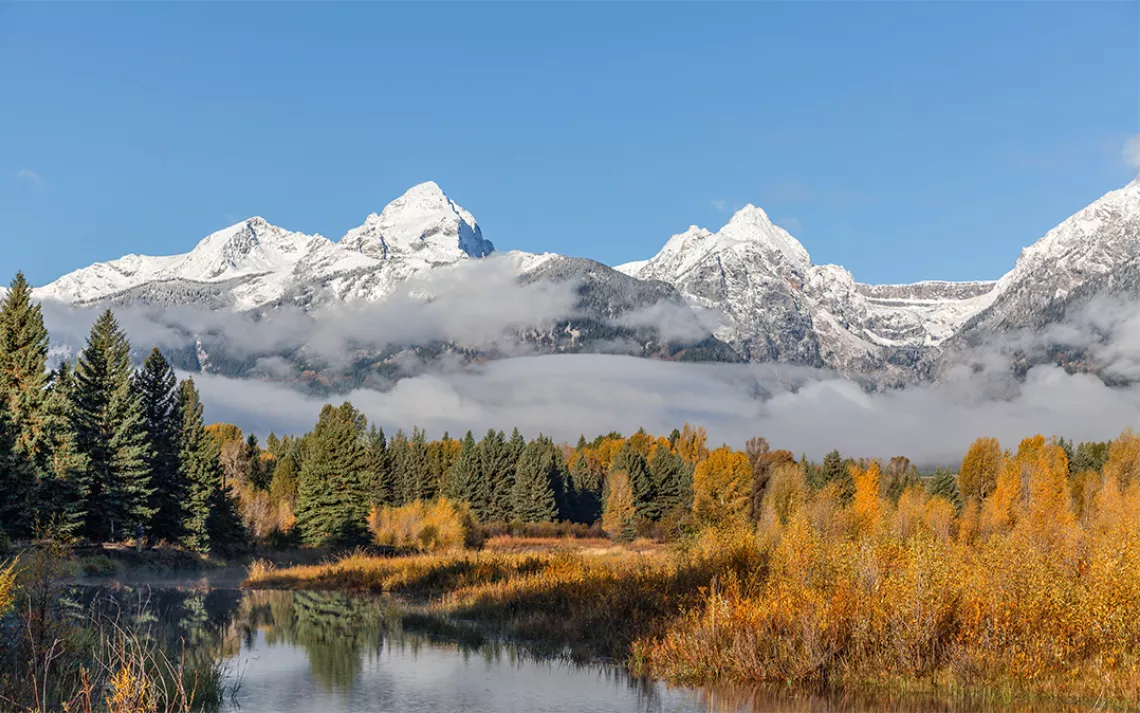Republicans Look to Roll Back the Antiquities Act
The Trump White House and GOP Congress are targeting Utah's new Bears Ears National Monument

Photo by twildlife/iStock
If you’ve ever stood on the rim of the Grand Canyon and marveled at the awesome view of the gorge—unmarred by mines or machines—you have the Antiquities Act to thank. If you’ve ever walked the banks of Wyoming’s Snake River and taken in the sight of the stone towers at Grand Teton National Park, you also owe a debt of gratitude to the Antiquities Act. The same is true of California’s Death Valley and Mt. Lassen National Parks, as well as Katmai and Glacier Bay National Parks in Alaska, Washington State’s Olympic National Park, and Arches and Zion National Parks in Utah. In all of these cases, the first step toward establishing a national park was for a president to designate a national monument under the Antiquities Act.
But this landmark conservation law is now in jeopardy. Montana representative Ryan Zinke, Donald Trump’s pick for interior secretary, has suggested that the new president might attempt to repeal or downsize some of the national monuments that President Obama established toward the end of his term. Such a move would be unprecedented: No president has ever sought to reverse a predecessor’s monument designations. And the noises about somehow revoking a national monument are likely just prelude to an eventual attempt by congressional Republicans to rewrite the law in its entirety to prevent future presidential monuments.
Before I go any further, some history might be useful. The Antiquities Act—it just sounds old, right? And, in a way, it is: 111 years old this year, to be exact, having been passed by Congress and signed into law by President Teddy Roosevelt, a Republican, in 1906. In this case, however, old doesn’t mean outdated. Instead, it means tested and proven.
The Antiquities Act was created as a response to an epidemic of looting and grave-robbing that swept the American West at the turn of the last century. Congress gave the president powers for “the protection of objects of historic and scientific interest.” In some cases, presidents have used that power to preserve landscapes containing archaeological treasures. Good examples include Arizona's Walnut Canyon and Wuptaki National Monuments, the Chesapeake & Ohio Canal, which runs through Maryland, and Hovenweep, along the Utah-Colorado border. Sometimes, presidents have leveraged the law to protect outstanding natural features, like the Petrified Forest and Craters of the Moon in Idaho. In many cases, the protection of archaeological and natural wonders overlap. See: Grand Canyon, the California Channel Islands, and the Bering Land Bridge in Alaska.
The United States’ first national monument, Devils Tower in Wyoming, is a classic example of how cultural and physical treasures are often one and the same. For the Lakota and Cheyenne peoples, the dramatic eruption of stone at the edge of the Great Plains was a sacred place. They called the site “Bear’s Lodge,” and the rock monolith was crucial to their star knowledge—their way of tracking the seasons. White pioneers, too, were naturally impressed by the sight, and when loggers and miners threatened the area, President Roosevelt moved to protect it. The fact that indigenous societies and white settlers alike apprehended a numinous power in the place seems, to me at least, to represent the best of America’s conservation traditions. What a wonderful example of how awe crosses cultures.
The brand-new Bears Ears National Monument in Utah clearly follows in the tradition of Devils Tower. Designated by President Obama right after Christmas 2016, the preserve covers 1.35 million acres of high desert flora and dramatic rock outcroppings, as well as thousands of sites containing relics of pre-Columbian societies—sites that in recent years have suffered from a rash of looting and vandalism. Given the intention of protecting archaeological sites, Bears Ears would seem to be a law-school textbook example of how the Antiquities Act should work.
Utah’s congressional delegation sees it differently. Jason Chaffetz, a Republican member of the House of Representatives, says Obama’s move represented an “egregious” disregard for the people of Utah. He and other Utah elected officials are pushing for President Trump to revoke the new monument. “If it was created by a pen, it can be dismissed by the pen,” Chaffetz told fellow Republicans at a party meeting in Philadelphia.
During his confirmation hearings to become interior secretary, Representative Zinke promised Utah senator Mike Lee that, if confirmed, he would travel to southern Utah to investigate the new monument for himself. “It will certainly be interesting to see whether the president has the authority to nullify a monument,” Zinke said.
Chaffetz’s confidence and Zinke’s curiosity are misplaced. Many scholars agree that while the Antiquities Act clearly gives the president the power to establish a monument, there is no procedure for a president to abolish one, since his predecessor’s designation would have the force of law (see here and here). A November 2016 report drafted by the Congressional Research Service—Congress’s nonpartisan policy research arm—cited a 1938 memo from the U.S. Attorney General’s office to conclude that the Antiquities Act “does not authorize the president to repeal proclamations, and that the president also lacks implied authority to do so.”
Christine A. Klein, a professor at the University of Florida Levin College of Law, who has also written about the act, helped walk me through the legalities. “This stuff you see in the news about presidents acting unilaterally or beyond his authority [in designating monuments] is simply not true,” she told me. “There have been only a handful of lawsuits challenging monuments designated by the president, and in every case the presidential actions were upheld—and that included two cases before the Supreme Court.”
The Antiquities Act, Klein explained, is a delegation of authority from Congress to the president. Accordingly, only a vote of Congress—not a simple swipe of the presidential pen—can revoke a monument.
Which is exactly what Representative Chaffetz and allies have as a Plan B in case Zinke’s “interesting” experiment doesn’t go as planned. A close examination of Chaffetz’s complaints about Bears Ears shows them to be pretty weak—and points to the larger agenda behind his campaign of small arms fire directed at the Antiquities Act.
Bears Ears opponents complain about the size of the monument, “one of the biggest land grabs in the history of the United States,” as Chaffetz likes to say. The law is clear, however, that the size of a monument is a function of its preservation goals: If the idea is to preserve thousands of antiquities spread across a couple thousand square miles, you’re going to need to protect a million-plus acres to get the job done. When Teddy Roosevelt set aside 800,000 acres to protect the Grand Canyon, mining interests complained as well—and then lost their case before the Supreme Court.
Bears Ears opponents also claim that this was an undemocratic process. “There is not a single . . . elected official that represents that area that’s in favor of it,” Chaffetz has said. Note the lawyerly wording there—“elected officials.” What about the people who live in the region? When former Interior Secretary Sally Jewell and other federal officials traveled to southern Utah last summer for a hearing on the proposed monument, proponents—led by a historic coalition of Native American tribes—outnumbered opponents by three to one. According to a statewide poll taken in spring 2016, 71 percent of Utahans supported the Bears Ears proposal.
The technical and procedural complaints disguise a larger ideological dislike of the Antiquities Act: Congressional Republicans hate the law, full stop. Representative Rob Bishop, a Utah Republican who chairs the House Committee on National Resources, has called the law “the most evil act ever invented” and has said that anyone who likes the Antiquities Act as written should “die” because he “needs stupidity out of the gene pool.” Bishop, Chaffetz, and others are angered by what they believe is federal overreach. Local communities, they argue, should decide how those lands are managed. I agree that local consultation is important—which is why those federal officials held the public hearings in the first place. But make no mistake: These are public lands, and they belong equally to all citizens, everywhere.
Bishop's and Chaffetz’s ultimate goal isn’t just to reverse the single national monument of Bears Ears; they want to roll back the Antiquities Act altogether. Bishop has repeatedly introduced legislation to change the law. The congressman refers to his legislation as reform—but in this case, “reform” is synonymous with “weaken” and “render meaningless.”
If you care about conservation and think the president should have the ability to protect lands when Congress fails to act, what is to be done? In the near term, as Trump and Zinke mull an attempt to revoke a monument by executive order, the fight is probably in the hands of lawyers. But eventually this issue will go to the floor of Congress. And when it does, the fate of this keystone environmental law will rest in your hands.
For more than a century, the Antiquities Act has protected some of America’s most outstanding landscapes. If congressional Republicans make good on their threats, it will be up to us to protect the Antiquities Act.
This article has been modified since its original posting.
What You Can Do
Oppose Ryan Zinke’s Nomination For Secretary Of Interior: Tell your Senators to oppose a Secretary of Interior nominee with a 97% track record on voting against our public lands. Send a message today.
 The Magazine of The Sierra Club
The Magazine of The Sierra Club







